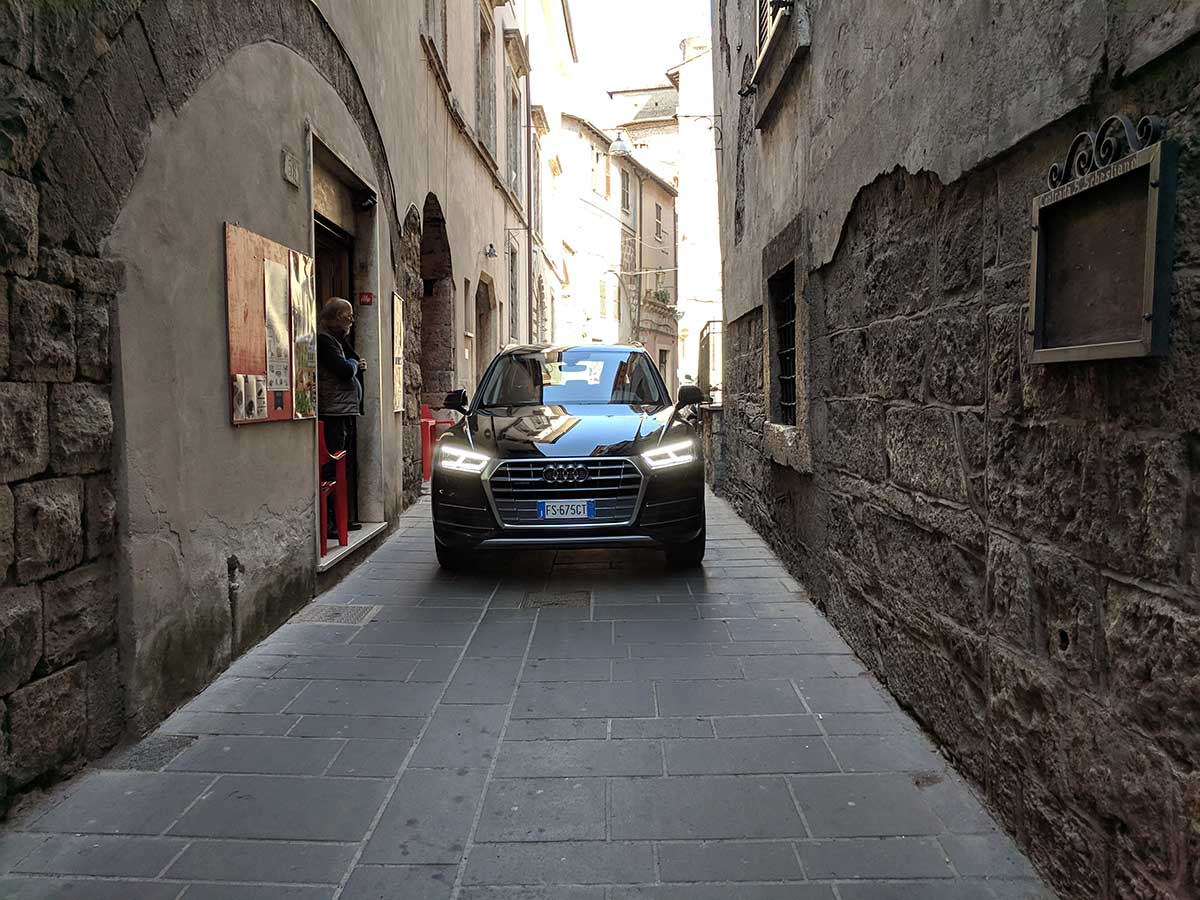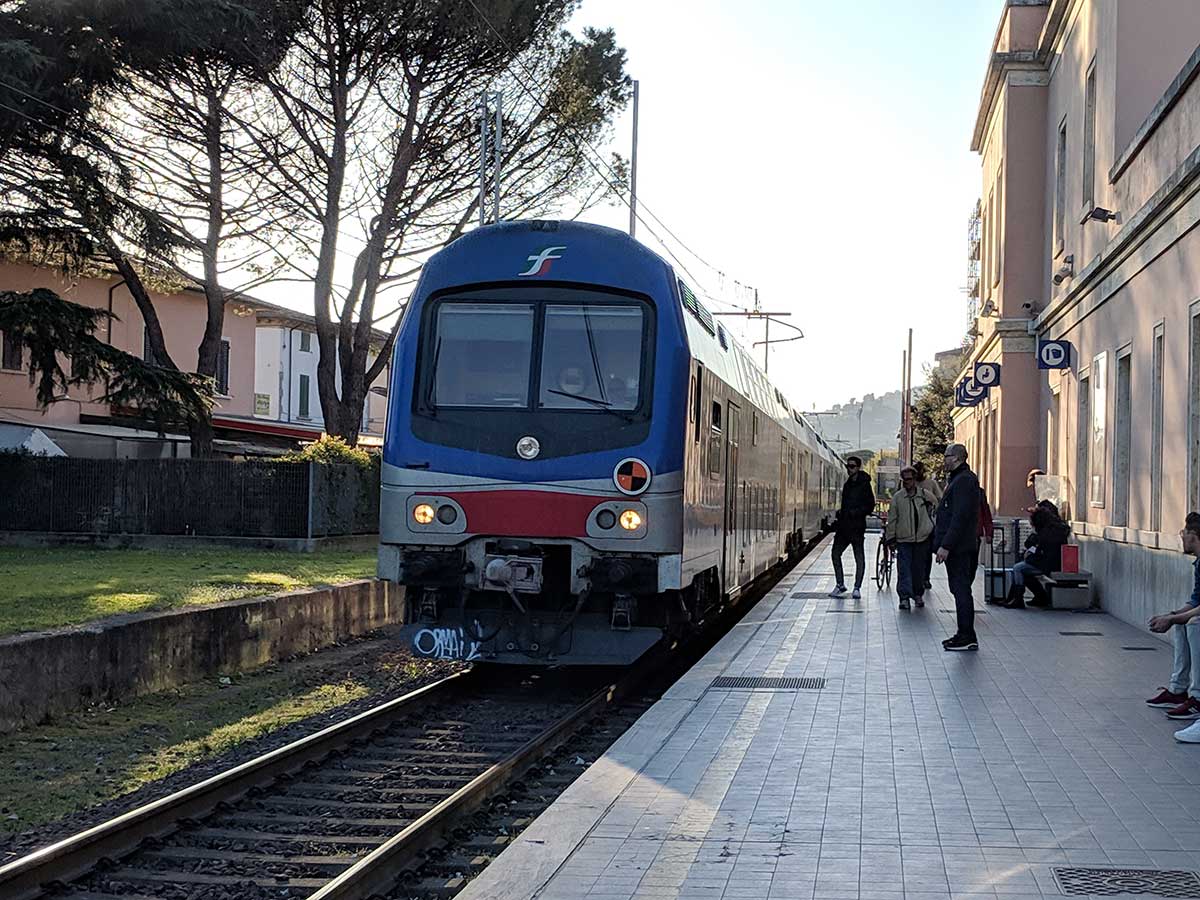Visitors from abroad rarely spend all their vacations in Italy in one town. Italy is packed with historical and cultural attractions and it is quite tempting to take a look at and visit at least a couple (oftentimes five or six) places during one trip. One of my friends once proudly declared: "We visited nine cities in seven days!" I am not sure what they managed to remember besides the transportation, but apparently that was their plan... We may agree or disagree about the "city-hopping" style of vacations, but more importantly, visitors wish to travel within Italy a lot and the question "How do we get there?" makes perfect sense.
Let's start our Italian journey at Rome's airport, as this is an entry point for millions of tourists arriving in Italy. There are two airports in Rome and if you travel internationally, you will most likely arrive at Leonardo da Vinci – Fiumicino Airport. After passing border control, follow signs for baggage claim and exit. As everywhere, you might have to wait a bit for luggage to show up on the carousel. Sometimes the wait is quite long. The good news? Look around and you will notice a few kiosks where coffee and panini are sold, and these are of very good quality. Do yourself a favor - taste Italy while you wait! Well, this is what I mean when talking about the "taste of Italy"; during your Italian vacation, there will inevitably be some delays and uncertainty, but if you take it easy and enjoy your coffee, everything will undoubtedly turn out good!
The next step would be getting from the airport to the town. Of course, there are taxis and Uber, and a one-way trip to the center of Rome should cost around 60 Euro. That is about the cost of four train tickets for the Leonardo Express, each of which costs 14 Euro (as of 2019). This train goes directly from Fumicino airport to Termini Station in the center of Rome, with a short stop at Tiburina Station in Rome. This nice, clean, air conditioned train will get you to town in 32 minutes. It departs every 15-30 minutes. The train station is easy to find: upon exiting the customs, turn right and follow the signs. You will walk straight for couple of minutes and then turn left, go down the escalator to the underpass, and up the escalator to the station.
Before boarding Leonardo Express make sure you bought a ticket. There are no tickets sold onboard, and the staff won't take apologies or "I didn't know" excuses. You can buy tickets in one of the machines in the station or while you are waiting for your bags to arrive on the belt. Those ticket vending machines look like this:

They are multi-lingual, so choose "English" and you will be alright. These machines also sell tickets for regional trains that are slower due to many stops along the way, so choose "Leonardo Express".
You will be prompted to choose the departure time. Actually, it is not important, so pick a time that you think will work for you, but if you get on an earlier or later train - no worries!
What is really important, though, is validating the ticket. Many of us would think that if you have chosen the time of departure, paid money and got ticket in your hand - that's all you need for the ride. But no! In Italy when you buy tickets for regional trains without specifying coach and seat numbers, it actually means that you can ride at any time on a given day. And how does one prevent passengers from riding few times a day with the same ticket? This is what the validation is for. It may seem strange to some, but perfectly logical for Italians. So look for these small machines:

They can be found randomly at the stations and on the platforms, but NOT inside the trains. Before boarding, insert your ticket into the slot and wait for a click inside. Now you are ready for a ride! Remember: if you forgot to validate ticket you may be fined 50 Euro or more.
Note that Italian railroads are sometimes affected by strikes. My Italian friends would correct me on this and suggest instead the word "oftentimes". The good thing about taking the Leonardo Express is that in case of a strike, Leonardo's passengers are offered a free replacement bus ride. This is especially important on the way from the city to the airport!
In Rome, public transportation is quite extensive. You can get practically anywhere using the subway (Metro) and buses. Buy tickets before boarding! Tickets are sold in vending machines on subway (Metro) stations, major bus stations and at newspaper stands, called Tabaccheria. Unfortunately, there are plenty of bus stops without vending machines. So plan ahead and carry a few bus tickets with you. On some buses you can pay fares to the driver. Do not forget to validate ticket inside the bus!
As any transportation, this can be quite adventurous!
I was in a situation once when my friend and I were about to leave Rome and after checking out of the hotel we went to the metro, planning to get to Termini station and catch the Leonardo Express to the airport. The metro, though, was closed due to a strike. Fortunately, we met two nice ladies who explained to us which bus to take in order to get to the station. Soaking from sweat and out of breath after a long run, we finally made it to the bus stop only to find out that the next bus was cancelled... And the bus after that was delayed. And there was no Tabaccheria nearby, which means no tickets. So when our bus finally arrived and we climbed in with our suitcases, we certainly did not look our best... The bus driver was very kind to the poor, desperate, disheveled tourists. He knew about the strike and assured us that we will get to the train station quickly and he will tell us when disembark. He also had tickets for sale, so everything turned out good in the end. But we learned our lesson: check for the strikes a day before (they are announced in advance) and plan an alternative route or method of transportation.
As for alternative methods: taxis in Rome aren't very expensive and you can easily arrange for a ride with mobile apps. I have used ItTaxi and MyTaxi, both worked equally well for me. You can choose your pick up point, look up the price - everything works the same as Uber or Lyft. The only difference is that you pay your fare directly to the driver. They accept both cash and credit cards, which is very convenient!
Transportation between cities
In my opinion, the best way to get from one city to another is to take a train. For longer distances choose "Freccia" trains. There are FrecciaRossa, FrecciaBianca and FrecciaArgenta, all of them are fast and comfortable. For example, it takes only an hour and a half to get from Rome to Florence. Of course, you trade one thing for another: the train will get you there faster, whereas if you rent a car, it will take some more time - but you can stop on the way wherever and whenever you want.
Driving a car is a nice form of leisure travel between big cities with some stops in little towns and wineries, beaches and spas. I would like to mention a few things worth keeping in mind:
Most freeways in Italy are paid routes. Be prepared to stop at the toll booths and pay when exiting. Fare will depend on the distance traveled.
Do not exceed the speed limit! Here in the US, we are used to seeing highway patrol officers chasing and stopping cars for speeding and handing out traffic tickets on the spot. So if you were not stopped, that means your speeding went unnoticed. In Italy there are speed cameras pretty much everywhere. They register all vehicles exceeding the speed limit and there is no way to escape. Sooner or later, the driver will receive notice of a traffic violation and will have to pay fines which could easily reach 100-200 euros or more. If you exceed the speed limit while driving a rental car, police will locate your address through the rental company and you might get an unpleasant surprise in the mailbox so much as six months after your vacations. Please think of other drivers' safety, stay safe yourself and save your wallet. Do not speed!
Before you enter any city, especially big ones like Milan, Florence, etc., please check ahead of time the map for ZTL: Zona Traffico Limitato. What does that mean? It means that not all vehicles are allowed in this area. Only ones with a special permit. Rental cars do not carry special permits, so stay away from these zones, which usually include the town center. Otherwise you will be fined.

Why were these zones created? Obviously, to relieve traffic jams and make it possible for local residents to park reasonably close to their houses. Besides, in many little towns central streets are very narrow. It takes certain skills and a smaller car to maneuver through that maze.

In Florence, for example, the whole center is closed off for vehicles without special permission. Check the boundaries! You can leave your car in one of the multistory parking structures and ride a bus or simply walk to the main attractions. The same holds true in many other cities.
Trains

There are several kinds of trains in Italy:
Freccia (Arrow): express trains with very few stops along the way, they are the fastest and most expensive. Tickets are sold with coach and seat numbers, no validation needed.
Diretto: direct train, less expensive than Freccia, has more stops. Tickets are sold with coach and seat numbers, no validation needed.
Regionale: they ran with a lot of stops, which comes in handy if you need to get to some small town, but obviously they are slower in traveling long distances. Tickets for regionale trains do not specify the coach and seat numbers and need to be validated before boarding. Keep in mind though that there are first and second class coaches, and if you bought tickets for second class, you cannot ride in a first class coach. Even if you got there by mistake, you may be fined. So please pay attention to the big "1" or "2" painted on the coaches.
If you need to change trains during your journey, leave yourself enough time to do so. I suggest at least 30 minutes between trains. Why? Because the first train might be late and you'll miss a connection. And you do not know in advance from which track the connecting train will depart. With rare exceptions, there are no schedule tables on the platforms, so you might need to walk through the underpass to the station, look at the schedule and then walk to the right platform. This takes time, especially with suitcase.
Useful apps:
TrenIt! https://play.google.com/store/apps/details?id=eu.baroncelli.oraritrenitalia&hl=en_US
Train timetable Italy https://play.google.com/store/apps/details?id=org.paoloconte.treni_lite&hl=en_US
ZonzoFox https://play.google.com/store/apps/details?id=com.xdkzonzofox.com.zmbuild&hl=en_US




